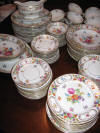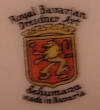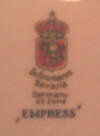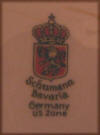On
September 1, 1939, Poland was invaded by Germany. It
was the start of World War ll, an era of immeasurable
tragedy and ultimate triumph over the evils of
totalitarianism.
Just a few days before, on
August 28th in the safe haven of the Bronx, New York, my
brother Lewis was born. To my six-year-old
sensibilities, it was as though I was given a new doll with
which to play. That early bond between us matured as
we did, and it grew into a loving friendship during those
wartime years of ration books, air raid drills, and
relatives serving in the Armed Forces from Italy to the
Philippines.
My parents, Morris and Sophie,
possessed a fine "sense of occasion" and we always
celebrated our birthdays, their wedding anniversary, and
various religious and secular holidays with great fanfare.
Our plans included surprises for the honoree, so there were
homemade gifts or simple store-bought ones that my brother
and I saved for from our weekly allowances of
twenty-five cents.
In the economic context of the
1940's, a nickel bought a phone call, a subway ride, an ice
cream cone, and a lamb chop. As a registered
pharmacist, with a degree from Fordham University, my
father's weekly salary was thirty-five dollars. The
monthly rent for our four room apartment on Nelson Avenue in
the Bronx was fifty dollars.
Central to our celebrations
were my mother's sumptuous dinners epitomized by her annual
Thanksgiving feast. Hospitality was one of the
elemental threads that were woven through the tapestry of
our HOME-SWEET-HOME, and a steady flow of family
and friends were entertained around our table throughout the
year.
For these special occasions my
mother presented her flavorful food on a set of magnificent
Bavarian china given to her by my father who probably paid
no more than one hundred dollars back in the 1930's.
When set with the fine porcelain china decorated with
bouquets and intricate garlands, my mother called the table
"her garden." The name of the china pattern is the
Schumann "Empress" Dresden Flowers.
I recall the ritual of
cleansing the dishes which usually were a bit dusty from
being stored well out of harm's way on the topmost shelf of
a kitchen cabinet. My brother and I watched with
baited breath as my father carefully lowered the fragile set
from the cabinet to a countertop. Preparatory to
immersing each piece in tepid water made frothy from Lux
soap flakes used at other times to wash delicate lingerie,
my mother lined our sink with a thick turkish towel.
This served as a cushion and reduced the chances of chipping
the precious dishes. Inevitably my mother's ritual
included a momentary pause from the chore at hand when she
would hold up a cup to the light to instruct me about the
fineness of the porcelain. One hallmark of quality was
the thinness of the piece, as I could discern colorful
patterns visible through the other side.
The rotund teapot did not come
with the original set, but was acquired by Lewis and me when
I was fifteen years old. At 5th Avenue & 52nd Street,
there was an upscale gift shop called Ovington's
Department Store, founded by Edward Judson Ovington (b.1831 - d.1931) and his brother Theodore. On one of
our window-shopping sprees with cousin Clare Eichenbaum
(which meant that we observed far more than we actually
purchased), I was astonished to see on display a teapot with
the identical "Empress"
pattern
of my mother's
dishes. I asked
the saleslady the price and was quoted twenty-five dollars,
a huge amount at the time.
That autumn, my brother and I
agreed that the teapot would be a perfect gift to celebrate
our parents' springtime wedding anniversary. They were
married on May 27, 1929, in a simple ceremony at the home of
Sophie's brother Jacob and sister-in-law Sylvia. It
was Aunt Sylvia's relatives, The Grubmans, who were furriers
with various business connections, who obtained the set of
Bavarian china. Our family legend had it that the
dishes were smuggled out of Germany just before the outbreak
of the war, circa 1938.
All through that winter of
1948, Lewis and I saved coins from our weekly allowances and
small earnings from chores until the quoted grand sum was
obtained. I returned to Ovington's, dumped
out on the counter twenty-five dollars worth of coins from a
little box that served as our bank, and the teapot became
ours! As I write, this very teapot sells for four
hundred seventy five dollars according to a website for fine
European antiques run by:
Sharon Dickinson Fine Antiques
P. O. Box 118
Lancaster, Texas 75146-0118
Phone: 972-227-0640 (Dallas
Area)
http://www.efineantiques.com
In 1964, my family
moved from the Bronx to an apartment in Stuyvesant Town on
the shores of Manhattan's East River. For the journey,
few of our possessions were packed as carefully as my
mother's dishes. They were used less and less as
Morris and Sophie grew more frail with the passing years,
until finally the set lay unused and stored away in my
closet for over a decade.
In 1998, my late brother
Lewis' daughter, Deborah, my cherished niece, called me from
a resort in Bali to announce the happy news that she was
going to marry Howard Saunders! He is from
Philadelphia, the city where she and her sister, my dear
niece Stacey, were residing and employed as social workers.
Debbie said that she and Howard wanted their wedding
ceremony to be in New York City. I expressed my
puzzlement at their choice of location because I knew all
their friends and Howard's family were from Philadelphia.
Then Debbie presented me with one of the greatest honors of
my life. She told me that they wanted my presence at
their wedding and wondered if they could be married in the
bedroom that is my year-round haven. I was overjoyed
and excited that among my plans for this milestone event, my
mother's "Empress" dishes would be used for the
buffet! They made an impressive presentation along
with her crystal goblets and sterling flatware.
After the wedding, the dishes
were packed away once again until 2007 when Stacey moved
into a rambling fieldstone house in Mt. Airy, Pennsylvania,
that is a mere bicycle ride away to Wynwood where Debbie and
Howard are raising their growing family of Leor and the
twins Gram and Lola.
Debbie favors contemporary
design, while Stacey likes the more traditional. With
Stacey settling into a cozy home,"where I could stay
forever," it was the perfect time for me to pass along to
her Grandma Sophie's Bavarian porcelain. She was so
appreciative of the esthetics of the dishes and the family
heritage imbued in each of the hundred pieces that I was
both touched and gratified. We held hands as I gave
her my blessing that "Her cup runneth over, that her
table should always be bountiful and surrounded by loving
family and friends." My sole wish is that the
dishes never be sold, but remain in our family. Stacey will
pass them to Lola Sophie, named for her Great-Grandmother, or
to the loving partners of Leor or Gram.
Certainly my mother Sophie
would be as happy as I to know that her dishes will be
passed along as a family tradition associated with happy
events. In 1938 how could any of us imagine that my
father's gift of love to her would touch generations far
beyond her lifetime?
Click here for Sheila's personal website (a truly
grand lady) and more of
her beautiful writings
Sheila Linton's
Schumann Collection
Royal Bavarian Dresdner Art was a product line name used by the
Schumann China Corporation of New York City for distributing
Schumann products in the United States, c.1931-1941.
Sheila's family history and pictures serve as excellent
documentation of this information and the dating of this
Dresdner Art Schumann mark shown below, which would have
been applied at the Schumann factory in Arzberg, Bavaria,
Germany, prior to shipment to America.
~~~~~~~~~
1938 Old Schumann Dresden with straight edge rim
that was the forerunner of what came to be called Empress



~~~~~~~~~
1948 Schumann Empress Dresden with the scalloped edge
rim


~~~~~~~~~
1948 Schumann "Dresden Swags" (as we have named
it)


~~~~~~~~~
1920's-30's Schumann Unknown version of
Dresden Flowers, older style reticulation


~~~~~~~~~